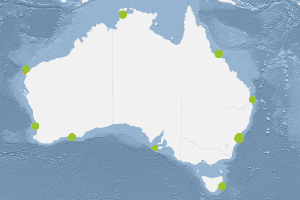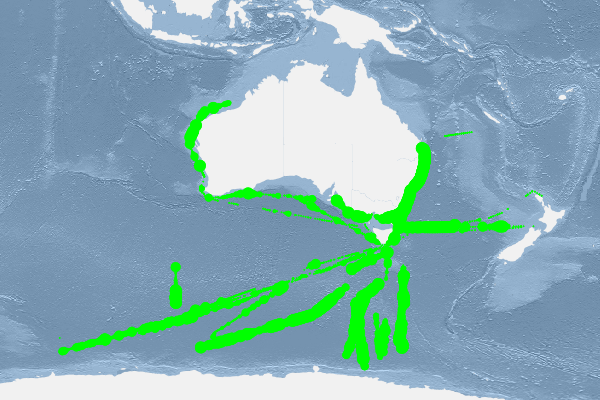Keyword
Earth Science | Biological Classification | Plants | Microalgae
28 record(s)
Type of resources
Topics
Keywords
Contact for the resource
Provided by
Formats
Update frequencies
Status
draft
-

This dataset comprises the phytoplankton abundance and biovolume estimates as part of a broader sampling program carried out at the Southern Ocean Time Series, a facility within the Integrated Marine Observing System (IMOS). The primary focus is sustained observing of ocean properties and processes important to climate, carbon cycling, and ocean productivity. Regular phytoplankton samples are collected at approximately 14 day intervals (exact intervals and seasonal coverage dependent on deployment length). The moorings are serviced annually, at which time the existing moorings are recovered and new moorings are deployed. Water samples from within the surface mixed-layer are collected at pre-programmed intervals using a Remote Access Sampler, in pairs about 1 hour apart. One sample in each pair is preserved for phytoplankton community composition by microscopy, and the other sample is preserved and used for accompanying chemical analysis of nutrients, total dissolved inorganic carbon (DIC) and alkalinity. Each sample is collected from within the surface mixed-layer at 32 m depth (2010 - 2017) or 5 m depth (2018-current) depending on the design of the mooring surface assembly and instrumentation. Typically a maximum of 24 samples are collected over an annual deployment cycle. The samples collected are analysed for: 1. Community composition / abundance (cells/L) 2. calculated biovolume (um3/L). Protocols for the phytoplankton time-series are described in Eriksen et al (2018), and the annual sample reports for each deployment. Data storage and access is planned to be interoperable with other national and international programs through the IMOS Infrastructure. Station metadata can be found through this resource. Data is available freely via the AODN portal: https://portal.aodn.org.au. As the taxonomic resolution of the data has changed over time, due to continual training, it is important that users refer to the change log tables included in your data download. These will provide information on the validity of the taxa, from what date we have been identifying certain taxa etc. Classification fields may be blank depending on the level to which that taxa has been identified, i.e. if only identified to family, genus and species will be blank.
-
This collection contains phytoplankton data collated from several state agencies and industry groups. This is time series data from water quality and seafood industry monitoring programs. As such this is a good resource for monitoring the occurrences of harmful algal bloom (HAB) and nuisance species in Australian coastal waters. Whilst this collection documents the abundances of HAB taxa, it can not be used to confirm the presence of any toxin. Most of the data are considered near shore or estuarine. The data are given in cells per litre of water for abundances, although some taxa are marked as present if they were seen in a sample but not in the formal count. Each verifiable taxon has been assigned an Aphia_id from the World Register of Marine Species website (WoRMS) where the full taxonomy of that entity can be found. If the Aphia_id is missing then the taxon name is not currently recognised by WoRMS. Data have been contributed by: Hornsby Council NSW & Microalgal solutions NSW Food Authority & Microalgal solutions Tasmanian EPA & Analytical Services Tasmania (AST)
-

The Australian Continuous Plankton Recorder (AusCPR) survey is a joint project between CSIRO Oceans and Atmosphere (O&A) and the Australian Antarctic Division (AAD) to measure plankton communities as a guide to the health of Australia's oceans. The biomass is analysed from the same segment from which the zooplankton is analysed. All the plankton is washed onto a pre-weighed filter. This is left in an oven at 60 degrees C for 24-48 hours. It is reweighed to give the dry weight. It is advised that anyone using the data should contact the project contact person. The aims of the AusCPR survey are to: * map plankton biodiversity and distribution * develop the first long-term plankton baseline for Australian waters * document plankton changes in response to climate change * provide indices for fisheries management * detect harmful algal blooms * validate satellite remote sensing * initialise and test ecosystem models. Servicing and maintenance of the CPRs and analysis of the samples for the AusCPR survey will be carried out by staff based at the O&A CSIRO laboratories in Queensland and Hobart and at the AAD in Hobart. The project was funded by the Integrated Marine Observing System (IMOS) and falls with the Ships of Opportunity facility. Data storage and access is planned to be interoperable with other national and international programs through the IMOS Infrastructure. Results from the AusCPR survey are available through the AODN portal: https://portal.aodn.org.au. This data is freely available but please acknowledge all relevant parties, as detailed in acknowledgement section.
-

Phytoplankton Colour Index (PCI) After the silk has been marked into 5 nautical mile samples but prior to cutting, each sample is visually assigned a greenness index by comparison with standard colour charts: viz. no colour, very pale green, pale green, and green. These four levels of the phytoplankton colour index (PCI) represent the amount of phytoplankton pigment on the silk and have been assigned numerical values on a ratio scale based on acetone extracts using spectrophotometric methods. Results from the AusCPR survey are available through the AODN portal: https://portal.aodn.org.au This data is freely available but please acknowledgment all relevant parties, as detailed in acknowledgement section.
-
This dataset contains the photosynthetic parameters determined experimentally from Productivity vs Light intensity experients (P vs E experiments), and primary production calculated using these parameters, collected on Franklin voyage FR 08/90, a part of the JGOFS study - Inorganic and Organic Carbon Cycles in Equatorial Waters. The voyage took place in the Solomon Sea, the Western Equatorial Pacific Ocean, Bismarck and Coral Seas during 02-17 October 1990. This dataset is archived within the CSIRO Marine and Atmospheric Research Data Centre in Hobart. Additional information regarding this dataset is contained in the cruise report for this voyage and/or the references.
-
This record is an overview entry for biological data collected on Franklin voyage FR 01/90. The voyage took place in the Tasman Sea and the Southern Ocean during 10-30 January 1990. This dataset is archived within the CSIRO Marine and Atmospheric Research Data Centre in Hobart. Additional information regarding this dataset is contained in the cruise report for this voyage and/or the references.
-
This dataset contains the photosynthetic paramters determined experimentally from Productivity vs Light intensity experients (P vs E experiments), and primary production calculated using these parameters, collected on Franklin voyage FR 05/92, a part of the JGOFS study - Inorganic and Organic Carbon Cycles in Equatorial Waters. The voyage took place in the Solomon Sea, the Western Equatorial Pacific Ocean, Bismarck and Coral Seas during 15 June - 13 July 1992. This dataset is archived within the CSIRO Marine and Atmospheric Research Data Centre in Hobart. Additional information regarding this dataset is contained in the cruise report for this voyage and/or the references.
-
This record is an overview entry for biological data collected on Franklin voyage FR 08/93. The voyage took place in the Solomon Sea, the Western Equatorial Pacific Ocean, Bismarck and Coral Seas during 5 November - 1 December 1993. This dataset is archived within the CSIRO Marine and Atmospheric Research Data Centre in Hobart. Additional information regarding this dataset is contained in the cruise report for this voyage and/or the references.
-
The Aquafin CRC Salmon Project is being undertaken by CSIRO Marine and Atmospheric Research (CMAR) and Tasmanian Aquaculture and Fisheries Institute (TAFI). Process Study 1 was undertaken between 12-14 April 2005 in the Huon Estuary offshore from Hideaway Bay. Prior to each microheterotroph grazing experiment, a CTD cast was performed at site P3 using the Seaboard 4550 to determine the depth of the fluorescence maximum. Water for a grazing experiment was collected from a depth of 20m (12 April) and 5m (13 April).
-

This dataset comprises the zooplankton abundance estimates of a broader sampling program carried out by the National Reference Stations (NRS) within the Integrated Marine Observing system. Regular monthly zooplankton samples are undertaken at the stations as part of a larger water sampling program by the National Reference Stations. In total nine stations are sampled regularly around the Australian coastline. Sampling is conducted monthly (Esperance and Ningaloo 3 monthly) off small vessels at each of the nine reference stations. The sampling is conducted using a drop net (as per the design of Heron) which has a 60 cm diameter, 100 micron mesh and is weighted to fall at 1 m/s. The net is designed to pull closed at the end of its fall so that it samples on the way down and does not sample on the way up. The depth of the sample varies at each station. 3 zooplankton samples are taken each month. 2 are fixed in formalin and will be analysed as described below. The unfixed sample is concentrated and frozen (-80oC)and will be used for molecular analysis in the future. The Port Hacking 4 (PH4) samples (2002 - Jan 2009) were sampled using a smaller net, 20 cm diameter, which sampled on the way up and down. The PH4 site is very close to the Port Hacking national reference station (PHB) where samples are now taken to build up and enhance the time series. The plankton ecology lab (based in Queensland) will analyse the samples collected for: 1. Community composition (Taxon/m3) 2. Biomass (dry weight in mg/m3) 3. Size spectrum analysis using zooscan (in progress) Data storage and access is planned to be interoperable with other national and international programs through the IMOS Infrastructure. Station metadata can be found through this resource. Data is available freely via the AODN portal: https://portal.aodn.org.au. As the taxonomic resolution of the data has changed over time, due to continual training, it is important that users refer to the change log tables included in your data download. These will provide information on the validity of the taxa, from what date we have been identifying certain taxa etc. Classification fields may be blank depending on the level to which that taxa has been identified, i.e. if only identified to family, genus and species will be blank.
